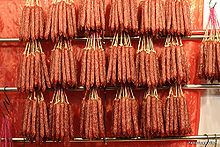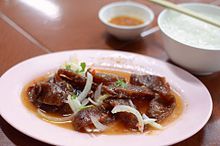- Chinese sausage
-
Chinese sausage 
Dried chinese sausages preserved sausage Traditional Chinese 臘腸 Simplified Chinese 腊肠 Literal meaning preserved sausage Transcriptions Hakka - Romanization lap cong Mandarin - Hanyu Pinyin làcháng Min - Hokkien POJ la̍h-chhiâng Cantonese (Yue) - Jyutping laap6 coeng2 - Yale Romanization lahp chéung liver sausage Traditional Chinese 膶腸 Simplified Chinese 膶肠 Literal meaning liver sausage Transcriptions Hakka - Romanization gon cong Mandarin - Hanyu Pinyin réncháng Cantonese (Yue) - Jyutping jeon2 coeng2 Vietnamese name Quốc ngữ lạp xưởng Hán tự 臘腸 Chinese sausage is a generic term referring to the many different types of sausages originating in China. It is commonly known by its Cantonese name "Lap Cheong" or "Lap Chong" (written as "臘腸" in Chinese).
Contents
Varieties
There is a choice of fatty or skimmed sausages. There are different kinds ranging from those made using fresh pork to those made using pig livers, duck livers and even turkey livers. Usually a livery sausage will be darker in colour than one made without liver. Recently, there have even been countries producing chicken Chinese sausages. Traditionally they are classified into two main types. It is sometimes rolled and steamed in dim sum.
- Lap Chang (臘腸) is a dried, hard sausage usually made from pork and a high content of fat. It is normally smoked, sweetened, and seasoned with Rose water, rice wine and soy sauce.[1]
- Ren Chang (膶腸) is made using duck liver.
- Xiang Chang (香腸) is a fresh and plump sausage consisting of coarsely chopped pieces of pork and un-rendered pork fat. The sausage is rather sweet in taste.
- Nuomi Chang (糯米腸) is a white coloured sausage consisting of glutinous rice and flavouring stuffed into a casing and then steamed or boiled until cooked. The Nuomi Chang of some Chinese cultures have blood as a binding agent similar to Korean Sundae
- Xue Chang (血腸) are Chinese blood sausages that have blood as the primary ingredient. Bairouxue Chang (白肉血腸) is a type of sausage popular in the North East of China that includes chopped meat in the blood mixture.
Regional
Southern China and Hong Kong
Chinese sausage is used as an ingredient in quite a number of dishes in southern Chinese provinces of Guangdong, Fujian, Jiangxi, Sichuan and Hunan, and also Hong Kong. Sichuan sausage also contain red chili powder and Sichuan pepper powder which give sausage a special flavor. Two common examples of such dishes include fried rice and lo mai gai. Many other examples include popiah and char kway teow in Fujian, Malaysia and Singapore. The traditional unpackaged forms are usually found in street market or wet markets.
Wing Wah is a famous Hong Kong company that produces Chinese sausages.
Northern China
 Smoked Sausages from Harbin
Smoked Sausages from Harbin
In Northeast China, a popular regional specialty is smoked savory hóng cháng (红肠,red sausage) similar to Polish sausages. It was introduced to Harbin by a German sausage maker in 1931. The sweeter dried version similar to southern Chinese sausages are also produced.
Myanmar
In Burmese, the sausage is called either kyet u gyaung (lit. chicken intestine stick; ကြက်အူချောင်း) or Wet u gyaung (lit. pork intestine stick; ဝက်အူချောင်း). The sausages made in Myanmar are more meaty and compact compared to the ones in Singapore or China. They are usually used in fried rice and along with fried vegetables, mostly cabbage.
The Philippines
In the Philippines, Chinese sausage is more popularly known as Chorizo(ng) Macau - with the Spanish-influenced one called Chorizo(ng) Bilbao. It is used in Chinese-derived dishes such as pancit Canton and Siopao Bola-bola, among others.
Singapore
Singapore has been coming up with many innovative Chinese sausages that are healthy.[citation needed] Examples that are created in Singapore are Chinese sausages with low fat, low sodium content and even a high fibre version.[2][3]
Taiwan
Taiwan also produces a similar form of sausage, however they are rarely dried in the manner of Cantonese sausages. As well, the fat and meat may be emulsified and they contain a larger amount of sugar and are thus sweeter in taste. These sausages are usually produced by local butchers and sold at the markets or made directly at home. This variant of Chinese Sausage is known as xiangchang (香腸) in Mandarin Chinese, literally meaning fragrant sausage.
Thailand
In Thai, the Chinese sausage la chang is called kun chiang (Thai: กุนเชียง) after its name in the Teochew dialect (kwan chiang in Teochew), the dominant Chinese language within the Thai Chinese community. It is used in several Chinese dishes by the sizeable Thai Chinese community, and also in some Thai dishes such as yam kun chiang, a Thai salad made with this sausage. There is also Chinese sausage made with Snake-headed Fish (Pla chon; Thai: ปลาช่อน) meat.
Vietnam
In Vietnamese, the Chinese sausage is called "lạp xưởng" or "lạp xường".
Outside Asia
It is available in Asian supermarkets overseas mostly in the vacuum-packaged form, although some Chinese groceries sell the unpackaged varieties as well. These tend to be made locally, for example much of the Chinese sausage sold in Canada is produced by a number of manufacturers based in Vancouver and Toronto. Lup Cheong is also a very popular sausage in Hawaii due to large amounts of Chinese in Hawaii, and have developed it into local cuisine, such as many local sausage companies, for example Kukui, makes Lup Cheong, as well as other regional varieties.
See also
References
- ^ CNN Go 40 Hong Kong foods we can't live without 13 July 2011. Retrieved 2011-10-09
- ^ Low Fat Sausages - Singapore Polytechnic.
- ^ Shitake Sausages - Singapore Polytechnic.
Hong Kong cuisine Food Almond biscuit · Almond jelly · Bakkwa · Banana roll · Bao yu · Beef ball · Beef bun · Beef chow fun · Bird's nest soup · Biscuit roll · Buddha's delight · Cart noodle · Cha siu baau · Char siu · Chinese herb tea · Chinese sausage · Cocktail bun · Coconut bar · Congee · Cream bun · Crispy fried chicken · Deuk Deuk Tong · Dim sum · Douhua · Dried shredded squid · Egg tart · Fish ball · Fish slice · Flame on the iceberg · Garland chrysanthemum · Got fan · Ham and egg bun · Haw flakes · Hong Kong-style milk tea · Hot pot · Jerky · Jin deui · Kai-lan · Lai fun · Mango pudding · Mister Softee · Nuomici · Paper wrapped cake · Peanut butter bun · Pineapple bun · Poon choi · Put chai ko · Rapeseed · Red bean ice · Rice noodle roll · Rice roll · Roast goose · Roasted pig · Rousong · Saang mein · Sausage bun · Sea cucumber · Seafood birdsnest · Shahe fen · Singapore style noodles · Siu mei · Steamed meatball · Steamed rice roll · Stinky tofu · Sweetheart cake · Swiss Wing · Taro cake · Taro dumpling · Tea egg · Tofu skin roll · Water caltrop · Water chestnut cake · White boiled shrimp · White cut chicken · White sugar sponge cake · Wonton · Wonton noodle · XO sauce · Yeung Chow fried rice · Yi mein · Yuanyang · Zha cai · Shrimp roe noodlesMovies Culture Places Categories:
Wikimedia Foundation. 2010.



